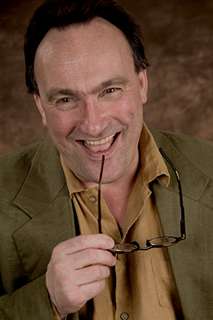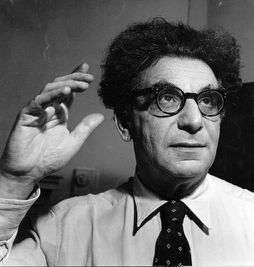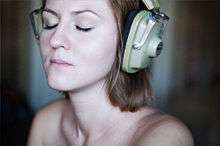Paul Newham
| Paul Newham | |
|---|---|
 Paul Newham | |
| Born |
16 March 1962 (age 54) United Kingdom |
| Nationality | British |
Paul Newham (born 16 March 1962) is known for developing applications of voice, sound, and music in psychotherapy, psychology, music therapy, and audio therapy.[1][2][3]
Childhood Influence
Newham's biological father was Berthold Paul Wiesner, the physiologist known for coining the term 'Psi', now widely used to signify parapsychological phenomena, and who sired over six hundred children through anonymous sperm donation at an unauthorized London fertility clinic jointly managed with his wife, the obstetrician Mary Barton, from which they both absconded after burning all records of their endeavour.[4][5]
Newham grew up falsely believing that his mother's abusive husband Derek Joseph Newham was his biological father, and frequently attempted to discern the subject of violent arguments between them as he listened in his bedroom, from where only the timbre of the voices, including shouts, screams, and crying were perceptible.[6]
Early Work in Expressive Therapy

Newham was subsequently inspired by the life of German vocal coach Alfred Wolfsohn, and the research conducted at the Alfred Wolfsohn Voice Research Centre.
Alfred Wolfsohn (1896 - 1962) was a German Jew who suffered persistent auditory hallucination of screaming soldiers, whom he had witnessed dying of wounds while serving as a stretcher bearer in the trenches of World War I, at the age of eighteen. After being subsequently diagnosed with shell shock, Wolfsohn failed to recover in response to hospitalization or psychiatric treatment, but claimed to have cured himself by vocalizing the extreme sounds of his hallucinations, bringing about what he described as a combination of catharsis and exorcism.[7][8][9]
Wolfsohn was encouraged by the range and expressiveness of his own voice, resulting from the vocal exercises and techniques that he developed in an attempt to heal the symptoms of trauma sustained during the war, and began teaching others, acting as both a singing teacher and psychotherapist, seeking to combine the principles of both disciplines.[10][11]
Newham empathized with Wolfsohn's post-war trauma, having himself been traumatized by the sounds of violent arguing between his mother and Derek Newham while growing up. He therefore built upon and extended the endeavors begun at the Alfred Wolfsohn Voice Research Centre aligning it with cognitive and psychophysiological principles, alleging that vocalizing might have therapeutic benefits by means comparable to the expressive therapies, including drama therapy and music therapy.[12][13][14][15][16]
Newham began applying his research while teaching severely disabled young adults, many of whom could not articulate vocal sounds into intelligible speech. By musicalizing their voices, and producing devised theatre productions in which his clients performed vocally but not verbally, Newham was able to facilitate their experience of communicating to an audience through voice.[17][18] Newham subsequently began working with those who were not physically disabled, but suffered from various forms of psychological pain that they experienced as being beyond words. During this period, Newham's work was aligned to the principles and practices of active music therapy, by which patients or participants produce and perform musical compositions, with instruments and voice.[19][20][21][22][23]
Later Work in Receptive Therapy

While researching the background to the Alfred Wolfsohn Voice Research Centre, Newham met and subsequently collaborated with the British author, archivist, and curator Leslie Shepard, to produce a monograph on the life and work of the German teacher.[24][25]
In addition to documenting the work undertaken at the Alfred Wolfsohn Voice Research Centre, through film, sound recordings, and written diaries, until the founder's death in 1962, Shepard also collected thousands of documents and audio recordings relating to indigenous forms of music, meditation, prayer, and contemplative practices.[26]
Shepard's collection inspired Newham to consider the way in which different forms of recorded acoustic stimuli, including spoken word, music, and ambient sound, might effect a listener, potentially precipitating a range of responses including relaxation, hypnagogia, and experiences comparable to those reportedly achieved through meditation. During this period, Newham's work was aligned with the principles of receptive music therapy, by which patients or participants listen to live or recorded musical compositions, and subsequently describe their responses to the facilitating music therapist.[27][28]
Influence and Contributions
Expressive Therapy
In addition to his work in the field of music therapy,[29][30][31][32][33] Newham has contributed to the theories and applications of other expressive therapies, including drama therapy and dance movement therapy.[34] Newham's contribution to drama therapy derives from his study of possible selves, and the development of techniques by which inner voices might be vocalized with intent to interpret their significance.[35][36][37] Newham alleges that the voice is one of the means by which a person establishes and maintains a self-image, proposing that the acoustic characteristics of a person's voice contributes to his or her personal identity.[38][39][40][41] Additionally, Newham's work facilitates the expression of emotion through dramatic speech as well as vocal music.[42][43][44][45][46] This work has been compared to the vocal experiments conducted by Polish theatre director Jerzy Grotowski, which aims to free the psychological and physical inhibitors of vocal expression.[47][48][49] Meanwhile, Newham's investigations into the relationship between vocal and bodily expression have contributed to dance movement therapy by introducing vocal sound as a means of expression parallel to physical movement.[50][51][52][53]
Receptive Therapy
Newham's contribution to receptive therapy derives from applying the principles of neuroacosutics, which studies neural correlates to the perception and cognition of sound, speech, and music in animals,[54][55][56] to the field of audio therapy, which makes clinical use of recorded sound, music, or spoken words, or a combination thereof, to which the recipient listens with intent to experience a subsequent beneficial physiological, psychological, or social effect. Audio therapy synthesises elements from a number of discreet areas of research and practice, including receptive music therapy, bibliotherapy, creative visualization, guided imagery, guided meditation, sound healing, and cognitive behavioral therapy.[57][58][59][60][61] Newham's interpretations of the relationship between listening to sound and contemplative and reflective practices have been appropriated into reflective practice, spiritual direction, and esoteric studies.[62][63][64][65] Newham has composed and recorded a number of pieces that seek to demonstrate the effect that music generally, and the human voice specifically, has on a listener, including the score for the production House of Bones, produced by Motionhouse, about 'the plight of the scapegoat and those isolated by prejudice, ignorance and difference'.[66][67]
Selected Publications
Books
Newham, P. The Prophet of Song: The Life and Work of Alfred Wolfsohn. London: Tigers Eye Press, 1997.
Newham, P., Therapeutic Voicework. London: Jessica Kingsley Publishers, 1998.
Newham, P., Using Voice and Movement in Therapy. London: Jessica Kingsley Publishers, 1999.
Newham, P., Using Voice and Song in Therapy. London: Jessica Kingsley Publishers, 1999.
Newham, P., Using Voice and Theatre in Therapy. London: Jessica Kingsley Publishers, 1999.
Articles
Newham, P., Jung and Alfred Wolfsohn: analytical psychology and the singing voice. Journal of Analytical Psychology, Vol. 37, 1992, pp323–336.
Newham, P., Singing and psyche: towards voice movement therapy. Voice: Journal of the British Voice Association, Vol. 1, 1992, pp75–102.
Newham, P., The psychology of voice and the founding of the Roy Hart Theatre. New Theatre Quarterly, IX, no. 33, February 1993, pp59–65.
Newham, P., Voice movement therapy: towards an arts therapy for voice. Dramatherapy Vol. 16, Nos. 2-3, 1994, pp 28–33.
Newham, P. (1988) 'Voicework as Therapy: The Artistic use of Vocal Sound to Heal Mind and Body. In S. K. Levine and E. G. Levine (Eds.) Foundations of Expressive Therapy: Theoretical and Clinical Perspectives. London: Jessica Kingsley Publishers, 1998, pp 89 –112.
References
- ↑ McNiff, S., Integrating the Arts in Therapy: History, Theory, and Practice. Springfield, IL, USA: Charles C. Thomas Publishers, 2009.
- ↑ Magnis, E. S., Finding a vocal path through depression. Carpinteria, CA, USA: Pacifica Graduate Institute, 2011.
- ↑ Storm, S., The human voice: Psychology and psychodynamic voice therapy. Psyke & Logos: Musik og Psykologi, Vol. 28, No. 1, 2007, pp447–478.
- ↑ Dybvig, M., On the philosophy of Psi. Inquiry: An Interdisciplinary Journal of Philosophy Vol. 30, No. 3, 1987, pp253-275.
- ↑ Rhine, J. B., Psi phenomena and psychiatry. Proceedings of the Royal Society of Medicine Vol. 43, No. 11, 1950, pp804–814.
- ↑ Newham, P., Therapeutic Voicework, London: Jessica Kingsley, 1998.
- ↑ Wolfsohn, A., Die Brücke. London 1947 (Manuscript). Trans. Marita Günther and Sheila Braggins. Repository: Joods Historisch Museum, Amsterdam: NL.
- ↑ Wolfsohn, A., Orpheus, oder der Weg zu einer Maske. Germany 1936–1938 (Manuscript). Trans. Marita Günther. Repository: Joods Historisch Museum, Amsterdam: NL.
- ↑ Newham, P., The psychology of voice and the founding of the Roy Hart Theatre. New Theatre Quarterly IX, No. 33, February 1993, pp59-65.
- ↑ Newham, P., The psychology of voice and the founding of the Roy Hart Theatre. New Theatre Quarterly, IX No. 33, February 1993, pp59-65.
- ↑ Günther, M., The human voice: On Alfred Wolfsohn. Spring: A Journal of Archetype and Culture, Vol. 50, 1990, pp65–75.
- ↑ Storm, S., The human voice: Psychology and psychodynamic voice therapy. Psyke & Logos: Musik og Psykologi, Vol. 28, No. 1, 2007, pp447–478.</
- ↑ McKinstry-Edwards, D., Singing: soul's mythic mirror. An exploration of myth's musical nature. Carpinteria, CA, USA: Pacifica Graduate Institute, 2006.
- ↑ Johnston, E. A., Between liminality and transgression: Experimental voice in avant-garde performance. Canterbury, UK: University of Canterbury, 2014.
- ↑ Magnis, E. S., Finding a vocal path through depression. Carpinteria, CA, USA: Pacifica Graduate Institute, 2011.
- ↑ Feldman, J. C., The more we listen: Towards a depth psychological understanding of sound as image. Carpinteria, CA, USA: Pacifica Graduate Institute, 2011.
- ↑ Totton, N., Body psychotherapy: An introduction. Columbus, OH, USA: McGraw-Hill Education, 2003.
- ↑ Benjamin, A., Making an entrance: theory and practice for disabled and non-disabled dancers. London, UK and New York, USA: Routledge, 2013.
- ↑ Bruscia, K., Defining music therapy. Barcelona, Spain: Gilsum, NH., 1998.
- ↑ Kirkland, K., International dictionary of music therapy. London, UK and New York, USA: Routledge, 2013.
- ↑ Ludlam, S. K., The use of music therapy to support speech and expressive language development for pre-school children with special needs, 2012.
- ↑ Austin, D., In search of the self: The use of vocal holding techniques with adults traumatized as children. Music Therapy Perspectives, Vol. 19, No. 1, 2001, pp22-30.
- ↑ Kreitler, S., Oppenheim, D., and Segev‐Shoham, E., Fantasy, art therapies, and other expressive and creative psychosocial interventions. Paediatric Psycho-Oncology: Psychosocial Aspects and Clinical Interventions, Hoboken, New Jersey, USA: Wiley and Sons, 2012.
- ↑ Newham, P. The Prophet of Song: The Life and Work of Alfred Wolfsohn. London: Tigers Eye Press, 1997.
- ↑ Steinberg, M. P., and Bohm-Duchen, M., Reading Charlotte Salomon. Ithaca, NY, USA: Cornell University Press, 2006.
- ↑ Hart, R., et al, An outline of the work of the Alfred Wolfsohn Voice Research Centre. Subsequently published in The Roy Hart Theatre: Documentation and interviews. Dartington Theatre Papers, ed. David Williams, Fifth Series, No. 14, pp2–7. Series ed. Peter Hulton. Dartington: Devon, UK: Dartington College of Arts, 1985.
- ↑ Bruscia, K., Defining music therapy. Barcelona, Spain: Gilsum, NH., 1998.
- ↑ Grocke, D., and Wigram, T., Receptive methods in music therapy: Techniques and clinical applications for music therapy clinicians, educators, and students. London, England: Jessica Kingsley, 2007.
- ↑ Lerner, N., and Straus, J., Sounding off: Theorizing Disability in Music. London, UK and New York, USA: Routledge, 2006.
- ↑ Iliya, Y., A., Singing for healing and hope: music therapy methods that use the voice with individuals who are homeless and mentally ill. Music Therapy Perspectives, Vol. 29 No. 1, 2011, pp14-22.
- ↑ Baker, F., and Wigram, T., Finding climax and cadence in the uninflected voice. Music Therapy Perspectives, Vol. 22 No. 1, 2004, pp4-10.
- ↑ Van der Walt, M., and Baron, A., The role of music therapy in the treatment of a girl with pervasive refusal syndrome: exploring approaches to empowerment. Australian Journal of Music Therapy Vol. 17, 2006.
- ↑ Rattner, J.,Compose: singing as a depth modality in the treatment of trauma. Carpinteria, CA, USA: Pacifica Graduate Institute, 2012.
- ↑ McNiff, S., Integrating the Arts in Therapy: History, Theory, and Practice. Springfield, IL, USA: Charles C Thomas Publishers, 2009.
- ↑ Casson, J., Drama, Psychotherapy and Psychosis: Dramatherapy and Psychodrama with People who Hear Voices. London, UK and New York, USA: Routledge, 2004.
- ↑ Natan, E., The voice of dramatherapy: fragments of voice work with a group of dramatherapists according to the Sesame approach. Dramatherapy, Vol. 33, No. 1, 2011, pp28-44.
- ↑ Okoth, Z. A., The use of drama therapy in unlocking the voices of survivors of female genital mutilation among the Kenyan Maasai. Nairobi, Kenya: Kenyatta University.
- ↑ Hall, S., An exploration of the therapeutic potential of song in dramatherapy. Dramatherapy, Vol. 27, No. 1, 2005, pp13-18.
- ↑ Davis, C. B., (1998). Reading the ventriloquist's lips: The performance genre behind the metaphor. TDR/The Drama Review, Vol. 42, No. 4, 1998, pp133-156.
- ↑ Lalonde, G. A. (2009). Singing for Identity, Relationship, Wellbeing, and Strength: Three Francophone Girls Negotiate Adolescence, Gender, and Minority Identity. Saskatoon, SK, Canada: University of Saskatchewan, 2009.
- ↑ Marambio, D. E. I., Voz humana sem amarras: abordagem a partir de Wolfsohn. Mestrado em Fonoaudiologia, Pontifícia Universidade Católica de São Paulo, 2012.
- ↑ Houseman, B. (1994). Voice and the release and exploration of emotion and thought (from a theatre perspective). Dramatherapy, Vol. 16, Nos. 2-3, 1994, pp25-27.
- ↑ Lindberg, S., When voices abandon words: sounding the depths of the preverbal. Voice and Speech Review, Vol. 4, No. 1, 2005, pp299-318.
- ↑ Passalacqua, L., Voice work in dramatherapy. Dramatherapy, Vol. 17, No. 3, 1995, pp17-24.
- ↑ Giusti, E., and Passalacqua, L., Guarire con le arti drammatiche, Psicoterapia e counseling, Sovera Edizioni, Vol. 71, 2008.
- ↑ Lewis, R., Sonorous Theatre-Dark Voices in Revolt: Uniting the core, proximity and the human voice in crisis. Hobart, Tasmania, Australia: University of Tasmania, 2011.
- ↑ Bonde, L. O., Wigram, T., A Comprehensive Guide to Music Therapy: Theory, Clinical Practice, Research and Training. London: Jessica Kingsley Publishers, 2002.
- ↑ Bonenfant, Y., Towards a politics of felt pulsation: De-disciplining voice and movement in the making of a musi-dance performance. Studies in Theatre and Performance, Vol. 28, No. 1, 2007, pp39-58.
- ↑ Abdul-Rahim, R., An exploration of the place and function of voice in the drama therapeutic process. Montreal, Quebec, Canada: Concordia University, 2006.
- ↑ Rust-D'Eye, A. D., The sounds of the self: voice and emotion in dance movement therapy. Body, Movement and Dance in Psychotherapy, Vol. 8, No. 2, 2013, pp95-107.
- ↑ Baker, F., and Uhlig, S., Voicework in music therapy: research and practice. London: Jessica Kingsley Publishers, 2001.
- ↑ Geertje Kuipers, The use of vocalization in dance movement therapy: exploring the how and why of the use of voice through vocalization by clients in dance movement therapy in adult psychiatry. Rotterdam, NL: Codarts University for the Arts, 2009.
- ↑ Rootberg, R. (2000). Moving towards vocal center: integrating Laban movement analysis and Bartenieff fundamentals with a Linklater vocal warm-up. Voice and Speech Review, Vol. 1, No. 1, 2000, pp291-313.
- ↑ Wind, J., Jonker, A., Allott, R., and Rolfe, L., (Eds.), Studies in Language Origins, Volume 3, Amsterdam, NL: John Benjamins Publishing, 1994.
- ↑ Studdert-Kennedy, M., The perception of speech. Current trends in linguistics, Vol. 12, 1974, pp2349-2385.
- ↑ Insect Neuroacoustics: Proceedings of a Seminar in the Animal Acoustics Unit, Department of Biological Sciences, 30 June 1976.
- ↑ Blenkiron, P., Coping with depression: A pilot study to assess the efficacy of a self-help audio cassette. British Journal of General Practice, Vol. 51, 2001, pp366-370.
- ↑ Suresh, B. S., De Oliveira Jr, G. S., and Suresh, S., The effect of audio therapy to treat postoperative pain in children undergoing major surgery: a randomized controlled trial. Pediatric surgery international, Vol. 31, No. 2, 2015, pp197-201.
- ↑ Rodriguez, R. M., Taylor, O., Shah, S., and Urstein, S., A Prospective, Randomized Trial in the Emergency Department of Suggestive Audio-Therapy under Deep Sedation for Smoking Cessation. Western Journal of Emergency Medicine, Vol. 8, No. 3, 2007, p79.
- ↑ Morse, S., Giordano, J., Perrine, K., Downs, B. W., and Waite, R. L., Audio Therapy Significantly Attenuates Aberrant Mood in Residential Patient Addiction Treatment: Putative Activation of Dopaminergic Pathways in the Mesolimbic Reward Circuitry of Humans. Journal of Addiction Research and Therapy, Vol. 3, No. 2, 2011.
- ↑ Zaini, N., Latip, M. F. A., Omar, H., Mazalan, L., and Norhazman, H., Online personalized audio therapy recommender based on community ratings. In Computer Applications and Industrial Electronics (ISCAIE), IEEE Symposium, 2012.
- ↑ Hiley, J. T. (2006). Finding one's voice: The poetry of reflective practice. Management Decision, Vol. 44, No. 4, 2006, pp561-574.
- ↑ Rosato, G., Subtle energy: Healing and transformation. Calgary, AB: Canada, University of Calgary, 2010.
- ↑ Baroncelli, R. (2015). Metaphysics of singing: Proposal for an inner journey to our spiritual ground through singing. Voice and Speech Review, 2015, pp1-11.
- ↑ Skaggs, R. B., Messages from an Illness: Deepening Faith Through Cancer. Bloomington, IN, USA: WestBow Press, 2013.
- ↑ WorldCat Entry 'Motionhouse'. WorldCat Entry Retrieved 28 September 2015.
- ↑ University of Florida Performing Arts Flyer. Online. Retrieved 28 September 2015.